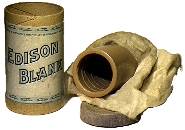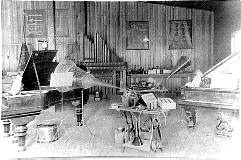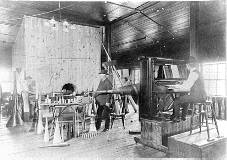Early Recording Sessions
Sound Waves Untouched by Human (or Electronic) Hands
Although the world was entering the era of electricity, a suitable electronic
method for recording sound was to prove elusive until the 1920's.
Early phonograph recordings were accomplished literally by brute force –
all acoustically: The performers would stand before a funnel-shaped horn
attached to a phonograph and belt out their tunes.
High volumes of sound
were required to force the recording diaphragm (made variously of glass, mica,
or copper) to vibrate sufficiently to force the cutting stylus to make a good
carving on the blank wax cylinder.
Due to the inflexibility of the recording diaphragm, some instruments did
not record well.
Instruments producing complex sounds, such as the violin, recorded weakly.
Not surprisingly, horned instruments recorded best.
Consequently, marching band numbers were prominent in many early recordings.
To produce a distinct recording, the number of instruments would also be
kept to a minimum – 15 or so for a band, 4 or so for a chorus.
Therefore, many early recordings present a simpler music by necessity.
Low-Tech Defined . . .

Edison blank cylinder, carton and cotton batting.
Photo credit 5.
Today, recording and disseminating sounds is direct and simple.
Spare a thought for how far things have come: With no method for mass-producing
copies of a single recording, early inventories of recordings were created
by huddling multiple phonographs near the performers.
Each phonograph would be operated simultaneously, each making a recording of the performance.
The recorded cylinders would then be replaced with fresh blanks,
and the process repeated.

"Making a Band Record with Thirteen Recording Horns."
Photo credit 3.
This way, for example, a band could make from 10 to 15 recordings per take.
Often, the band would then repeat the same tune, take after take.
At, say, around ten-minutes per take, up to 90 records could be produced
per hour . . . all being well.
Pity the singing performers: Only about 4 phonographs could acceptably be used
simultaneously – netting maybe 24 records per hour . . . another
reason band music was popular in the early days.
Listen to an example of just such an early band recording –
From 1897, the Liberty Bell March
 by the Edison Concert Band.
by the Edison Concert Band.
For help playing this excerpt, click here.
[ Facsimile of The Phonogram, 1891, page 226. ]
Phonograph Records by the U.S. Marine Band
The music of the United States Marine Band, of Washington, D.C.,
is now so well known to the users of the phonograph and the patrons
of coin-slot machines, that The Phonogram, desiring to give its
readers precisely what they want, irrespective of cost, has procured,
after considerable effort and expense, the fine photograph of that band
while it is making records for the Columbia Phonograph Company.
The photograph shows the band in full uniform, as it appears when playing
for the President of the United States at the White House, on state occasions,
or in the grounds of the White House in pleasant weather.

Photo credit 2.
See note 3.
Click here to see a close-up.
This is, in many respects, the most celebrated band in the world.
It can play, without notes, more than five hundred different selections.
Much of the music played by this band to the phonograph has been arranged
especially by the band with a view to the best phonograph effects;
and the patient experimenting of Professor Bianchi, who is in charge of
the musical department of the Columbia Phonograph Company, has borne fruit
in an output of superior records.
With regard to musical records, it may be here stated that anyone possessing
an ordinary knowledge of the phonograph can make them, but perfect records
are only obtained by using the utmost care and precision in placing the
horns and by the perfect running of the phonograph.
|
Soon, primitive duplicating methods were devised by
connecting one phonograph to another.
An early approach used a hollow rubber tube running between the master
and duplicating phonographs.
Later, direct linkage connected the reproducing stylus of the master to the
cutting stylus of the recording phonograph thus duplicating pantographically.
Only a limited number of copies – which typically had an inferior, brasher sound –
could be made using these techniques due to the wearing down of the wax master.
In Search of the Big Sound
Another odd chapter in wax cylinder recordings began in 1898,
when Columbia and Edison undertook to advance the state-of-the-art in sound recordings
by offering 5" diameter brown wax cylinders records.
Columbia called them graphophone grand records, while Edison named them simply concert records.
Much larger than standard-sized cylinders,
concert cylinders delivered on their promise of a louder, clearer recording, but at a price:
$5, compared with a typical 50¢ to $1 for standard records;
not to mention the necessity of a special phonograph to play them on.
While most early concert cylinders were original (master) records, producing a clear,
loud sound, many later concert cylinders were simply pantographic copies,
which virtually eliminated any advantage they had over standard brown wax cylinders.
In 1902, wax cylinders made by a molding process became available; this was a big improvement.
Now, instead of records being individually cut from a soft wax blank,
which limited the recording's playback lifetime,
records were molded using a firmer black metallic soap-wax concoction.
Generally, these new generation molded "black wax" cylinders were able to hold a louder
and clearer recording, and suffer less obvious wear than "brown wax" records.
However, all generalizations are bad (including this one, of course),
and there are many instances of brown wax records containing superior fidelity recordings,
and black wax records heavily "chewed up" from wear.
Many two-minute cylinder recordings were self-announcing.
This was standard practice from the earliest days of sound recording
when most records were made for coin-in-the-slot nickelodeons (1888-1895), and also because,
silly as it may sound, there was no reason not to self-announce recordings.
In addition, the labeling of most early wax records was limited to a paper slip
that came with the record indicating the title and performer of the recording.
By 1904, both Edison and Columbia provided labeling on the cylinder's edge and
by early 1909 most cylinder records were no longer self-announced.
Listen to a self-announcement –
From 1904, Southern Smiles Two-Step
 by the Edison Military Band.
by the Edison Military Band.
For help playing this excerpt, click here.



 Copyright (C) (P) 1996-2024 Glenn Sage, Portland, Oregon. All Rights Reserved.
Contacting Tinfoil.com.
Copyright (C) (P) 1996-2024 Glenn Sage, Portland, Oregon. All Rights Reserved.
Contacting Tinfoil.com.






